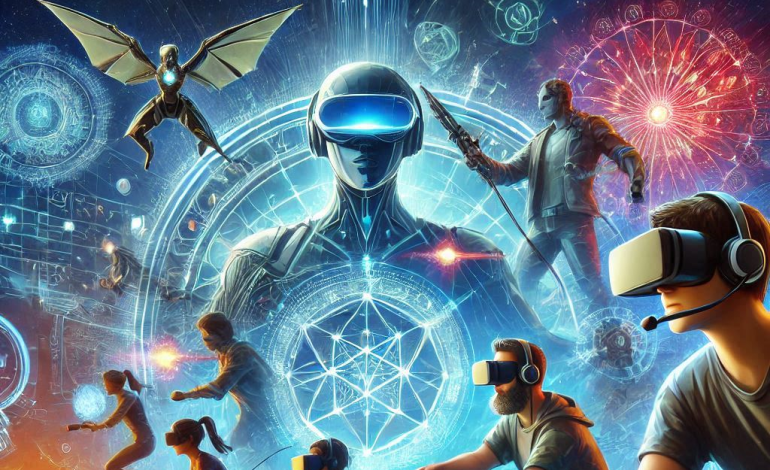Convergence of VR Gaming and the Metaverse: The method of convergence, according to the developers.

Virtual reality gaming is one of the transformative technologies in the recent past that has redesigned the boundaries of immersive entertainment. Such developments are making the gaming industry use such building blocks for the metaverse, which is a collective virtual space that is a mix of both the physical and digital worlds, where availability of VR hardware and accelerated innovations in software will be the reasons.
It rewrites not only the way of coming up with games but also rewriting the possibility of remaking the way humans relate and interact with each other virtually. Essentially, it is driven by the progress of advancing advances in VR gaming development coupled with collective efforts on the part of Metaverse Game Development Company spearheading the digital revolution.
The core of it, VR gaming is deep to immersion with regard to experience beyond normal platforms. They come in here with worlds of digits fully realized; it is possible to engage real-time conversations with the environment and any characters in that world. This immersion eventually becomes a valuable stepping stone into the metaverse, conceived of as a persistent, shared space.
Unlike the traditional gaming model, where interactivity is between the screen and controller, VR brings presence to the fore because it makes the user feel like he or she is really there in a virtual world. This capability fits like a glove into the idea of a metaverse – creating interconnected experiential spaces where people socialize, work, and play. That is the shift from the stand-alone VR games to interconnected metaverse experiences requiring a significant technological and creative breakthrough. Developers take the concepts and ideas developed in VR gaming little further toward the very core of developing large virtual worlds that exist outside and beyond the game long after the game itself has. This aggregation of the foregoing factors, driven by real-time physics, user-created content, and social interactions that closely mirror those seen in real-life relationships, should make them seem alive and interesting.
The foremost leaders in convergence are the roles taken by the Metaverse game development companies
In particular, the specialized companies unlock the potential that the VR gaming technologies have held over the creation of the type of infrastructure the metaverse needs. It specializes in designing scalable virtual worlds that fully utilize real-time rendering while offering smooth interaction to the users. Such companies are building immersive interactive environments that form the basis of metaverse experiences through their utilization of the services provided by tools such as Unity’s game engine and Unreal Engine. All these advanced features, from AI-driven NPCs to dynamic environments and platform compatibility, add depth and width in virtual space.
The biggest problem while trying to get VR gaming into the metaverse is interoperability. The metaverse strives to harmonize a digital space that will allow a user to transition between divergent virtual worlds in an efficient way. That’s where breakthroughs in technicalities, like synchronized data, integrated platforms, and standardized processes come into play, breaking down these to a developer. After all, VR gaming has paved its way with driving innovations from real-time rendering to motion tracking and much more, but scaling into an entirely realized metaverse still requires interdisciplinary collaboration. This will ensure easy connectivity and data sharing between virtual environments within disparate domains through open standards and decentralized platforms, most dependent on blockchain.
Of course, one of the most important key features is social interaction. One has to say that VR gaming has had so much to do with redescribing how users connect in virtual space. How real-time collaborations have showed community sense is very understandable in multiplayer VR.
For instance, avatars enable people to interact with other users and engage in collective activities during games of VRChat, Rec Room and Virtual darling. These are mini-metaverses that show how immersive technologies can be integrated. The developers take these concepts further by integrating voice recognition, gesture tracking, and haptic feedback for natural interactions in virtual worlds. The second factor leading to VR gaming integration with virtual worlds is that the metaverse forms economic opportunities. Though the metaverse environment is more complex in terms of complexity, this aspect guides the creators, as they design the even more complicated environments and thus develop new revenue streams as well. The economy of metaverse integrates virtual goods and in-game currencies, for instance, digital real estate.
Already, virtual reality gaming has entered the process of getting the user into the mindset of buying and owning virtual assets. This is magnified in the metaverse. Because of blockchain technology and NFTs, the users can now trade and own unique, value-bearing digital items associated with their virtual interactions. It can be asserted that VR gaming impacts the advancement of metaverse since it largely depends on user-generated content. Most games played in VR enable the individual players to create and share experiences, thus making the development a culture of creativity and collaborative experience. User-generated content drives the engagement and diversities in this ethos while its heart is found at the middle of the metaverse. Horizon Worlds and other virtual environments, such as Second Life, show how VR technologies allow the user to design their virtual worlds and shape this virtual terrain.
Now, developers will make less complex tools and interfaces usable enough that every level of user could participate in the metaverse capable and be an actual innovator democratizing innovation possibilities in content creation.
The other key enabler that will help to bridge the gap between VR gaming and the metaverse is hardware development. High-resolution displays, along with the advanced tracking capabilities in light and wireless VR headsets, have really made VR gaming much more accessible and appealing. The hardware is always improving companies like Meta (Facebook), HTC, and Sony, along with many more related to innovative technology, creating better, seamless experiences with gadgets that now have come forth for seamless gaming experiences as well as enjoyable purposes in a metaverse for foundations to be scalable. Therefore, even the lines that divide reality from virtual reality will be much less palpable, so eye tracking, hand tracking, and even haptic feedback technologies blur into making the metaverse a place that is more tangible and interactive.
Besides, the interaction of metaverse and VR games encouraged innovation in AI. This is due to the fact that artificial intelligence plays a crucial role in providing lifelike environments and interactive characters that always react to whatever the user might do. In virtual reality games, AI assists in simulating behavior and interaction in real manners to make gameplay more richer. Other than playing games in the metaverse, AI powers virtual assistants, allows for automated content creation, and allows customization of user experiences. For instance, through these algorithms, it may be able to help a user analyze preference in providing an activity, or even propose connections or personalize environments according to his or her needs. This extent of personalization and flexibility is needed to bring at least almost a semblance of life to the metaverse and to have interactivity. The problems do not end there either as VR gaming is also meshed in the metaverse. Data privacy, security, and ethics issues are raised to this date by the growth complexity and scale of virtual spaces, which are gaining importance with each passing day. It demands developers to address these issues so that the metaverse is safe and inclusive. For example, VR gaming has already shown a need for online interaction moderation to prevent harassment and abuse. When these protections are extended to the metaverse, they require robust moderation tools, clear community guidelines, and a commitment to user safety. Decentralized technologies raise governance and accountability issues that have to be handled with care not to damage the trust and transparency. Even though there are all these issues, the future of VR gaming and the metaverse does seem very bright. Developers, therefore, who merge the worlds pave the way for transformative experiences that redefine entertainment, socialization, and commerce.
Innovation at this unprecedented speed is driven by collaboration between VR game development companies and Metaverse Game Development Companies pushing the boundaries of what’s possible in virtual environments. From creating hyper-realistic simulations to forming global communities, the fusion of VR gaming with the metaverse constitutes something like a new frontier in interacting with the digital. VR gaming is therefore the bedrock of the metaverse. Capabilities of VR and infrastructural technology toward the realization of this concept lie at its base. With contributions from game developers and Metaverse Game Development Companies, both categories end up as a single interlocked virtual world which is possible and boundless. With hardware and software innovations and artistic evolution, the line between games and reality blurs as man approaches a new era in immersiveness. It means changing not only how we play but also how we connect, create, and explore in this digital age when the fusion of VR gaming and the metaverse is concerned.









